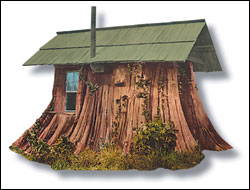WHEN I WAS A KID, the Seattle air-raid sirens wailed every Wednesday at noon. For a long time, it was merely hometown background noise, like the distant blasts of ferry or train whistles that floated in through my window at night from the downtown docks and rail yards. During the Cuban Missile Crisis of 1962, it took on a more ominous note, especially as we grade-schoolers were sometimes taken into the school basement for “earthquake drills” or told that, in event of nuclear attack while walking to or from school, we should lie down in the street, facedown in the gutter, and cover our heads and necks.
Even to my young mind, that seemed rather inadequate. I begged my parents to buy a home with a bomb shelter but was told that my father’s basement darkroom would have to serve. It seemed unprepared for most emergencies, being filled with photo chemicals and cases of Heidelberg beer. I couldn’t figure out whether my parents felt no sense of threat, or whether they simply didn’t care. I cared. I was terrified of nuclear annihilation and spent many years expecting it. I remember a famous cover of Time magazine featuring Soviet Premier Nikita Khrushchev against the backdrop of an atomic mushroom cloud. “We will bury you,” he said, and I believed him.
MANY PEOPLE experience much worse because they live where bombs actually fall. We luckily did not. But during the Cold War, it was brought home to us that Seattle was not really a backwater, safely tucked off in an obscure corner of the continent. The Soviet Union practically touched Alaska, the place Seattle was “Gateway” to. We were reminded that Puget Sound offered many tempting first-strike targets, such as Boeing and the Naval shipyard at Bremerton. The military-industrial complex played a huge role in building our city and state, and this had not gone unnoticed by our enemies.
In my early teens, I remember reading Nevil Shute’s novel On the Beach. In one part of the book, some survivors of a massive nuclear war that has wiped out the Northern Hemisphere visit Seattle on a submarine. One of the crewmen who lived in Seattle jumps ship—to certain death from radioactive fallout—and goes to find his family’s home somewhere in the Rainier Valley, my old neighborhood. The city is a post-nuclear ghost town. I used to walk my P-I paper route along Rainier Avenue imagining this scenario in the wee hours of the morning when the streets were empty. If I were the lone survivor of an atomic war, I could take everything I wanted from Chubby & Tubby and stay up late and snoop in peoples’ empty houses. If I were the last man on earth, I certainly would quit my paper route. Beyond that, there seemed to be little upside.
NUCLEAR FEARS ARE back, after a brief post-Cold War respite. And Seattle, though ideologically isolated from the rest of America in its anti-war views, is again a prime target for weapons of mass destruction. We are largely a city of peaceniks surrounded by the infrastructure and industry of war: military bases, defense contractors, shipyards, high-tech companies. If Seattle was a tempting target to our enemies in 1962, we are even more tempting today. And our geography makes us reachable. One possibility is that some terrorist group will bundle up a dirty bomb or suitcase nuke and cross the border from Canada. (Remember bomb-plotter Ahmed Ressam, caught crossing at Port Angeles shortly before New Year’s Eve 1999?) Or send one sailing into Elliott Bay aboard one of the innumerable container ships that reach our port.
But the recent renewed nuclear brinksmanship of North Korea should be especially sobering. It highlights the vulnerability of our position on the Pacific Rim. In 1998, the North Koreans tested a new generation of missile by firing it over Japan. The missile was more advanced than expected, and analysts believe it proved they had technology capable of carrying a small warhead—nuclear, biological, or chemical—as far as Alaska. In 2000, a senior North Korean scientist defected to South Korea and said his country had developed a missile capable of reaching California. This is likely the so-far-untested Taepodong II missile, believed to be potentially able to carry a nuke to the Western U.S., according to a report by the Union of Concerned Scientists. Seattle should take developments on the Korean peninsula as seriously as do the rest of our Rim neighbors, because when Kim Jong Il rattles his nuclear saber, he’s rattling it at us.
Ironically, the threat to the relatively liberal, war-reluctant Northwest is being used to justify building a missile defense system. The Bush administration announced before Christmas that a limited defense would be deployed by 2004. It isn’t Star Wars. Interceptor missiles will be based at Fort Greely, Alaska. Their goal will be to try and knock down any unwanted airmail coming our way from Pyongyang, though there are serious questions about whether this system will even work.
As stupid as the prospective war in Iraq is (even more unjustifiable in light of our apparent commitment to diplomacy with North Korea), it doesn’t negate the importance of taking reasonable defensive measures against potential attacks here. It also underscores the importance of our engagement in international issues. The nature of the threats—and our country’s response to them—makes us all players in the world drama. Terrorism and North Korea are, unfortunately, local issues now, and they will be for a long time to come.







